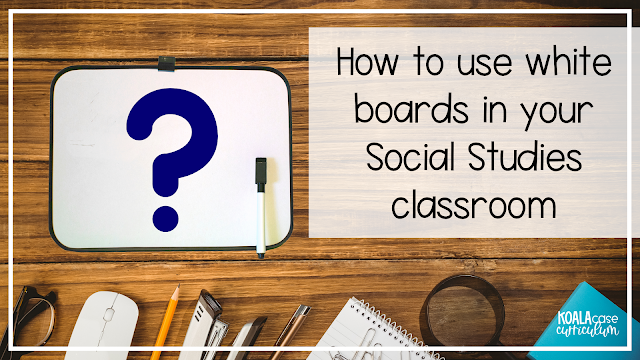Whiteboards in the classroom are so
underrated. They are a fantastic way to make sure students understand the
material being covered. This subtle classroom management tool helps curb
off-topic conversations among students all while giving you insight on where to
strengthen instruction. Whiteboards also come with a host of other benefits.
They often help:
● shy
students be vocal and get participation points without having to raise their
hand and speak.
● students who might be
struggling to feel empowered. They can participate without the fear of feeling
less smart than their classmates who know the answers.
● students who always know the
answers can participate without becoming the loudest voices in the class.
 |
| I 💓 chisel tip markers! |
With
the benefits in mind, you can make a sound decision on if it is for you and
your students and how you would like to implement the practice. This includes
what type of board you want for your classes. Be sure to select your board on
criteria of cost and durability.
Your whiteboard options:
- Dollar stores - If you are worried about the affordability of a class set, check local dollar stores and value shopping centers for low-cost options. While materials may not be bundled, it is possible to get a class set for $30 or less!
- Teacher Supply Store - If dollar stores is not an option for you, another cost-effective option is card stock covered in 5mm laminate. For around$10, a class set can be made at local office or teacher supply stores. After the actual dry erase board, this is the sturdiest alternative.
- Page protectors - If you find yourself pressed for time and restricted by budget, you can always use printer paper inside of page protectors. This option isn’t as durable or mess free, but it gets the job done.
 |
Once
you’ve selected your preferred whiteboard, it is time to establish guidelines
of using whiteboards in class.
Some sample guidelines include:
● Whiteboards are only to be
used for writing answers to the questions being asked. Only write on them when
asked to or with permission.
● Dry erase markers are only
for use on dry erase surfaces, not hands, books or paper.
● Everyone should try to answer
the question with a response related to the subject. It’s okay to be unsure or
incorrect, but an educated attempt is required.
● Once an answer is written,
leave the whiteboard face down on the desk until instructed otherwise.
I
highly recommend posting the guidelines in plain sight. This is great for you,
those students that may have a hard time remembering and those that are visual
learners. Using whiteboards with guidelines can be a little cumbersome in the
beginning, but eventually, it becomes a part of the classroom culture.
Now
that you’ve set up your guidelines, it is time to actually use the whiteboards.
5 Easy Steps to Using Whiteboard in Class
3. After seeing all responses, have students return their board to face down and discuss their answers with a partner. If there is any confusion, this is a low-pressure opportunity to receive peer feedback without being called out in class. This is also when students are allowed to change answers.
4. When partner collaboration is complete, ask one student to share their now correct answer and explain it. Those students that changed their answer will now have an opportunity to explain the correct answer which helps them retain the information.
5. Repeat! Walk through this process for two or three questions then move on with the main activity.
Using whiteboards is amazingly simple, but
highly effective. Once incorporated into the fabric of the classroom, you’ll have the
freedom to use this tool as a part of regular instruction and special
occasions, like classroom observation.
How
excited are you to try out these ideas? Your students are going to love using
this in class, and I would love to see how you use this idea. Leave a comment below if you've tried this out or how you plan on using them 👍
 |
If
you are looking for some great tips on using whiteboards in elementary grades, check out this
great list!
Want
more info on whiteboards being used in class? Check out this fantastic
list of resources.




